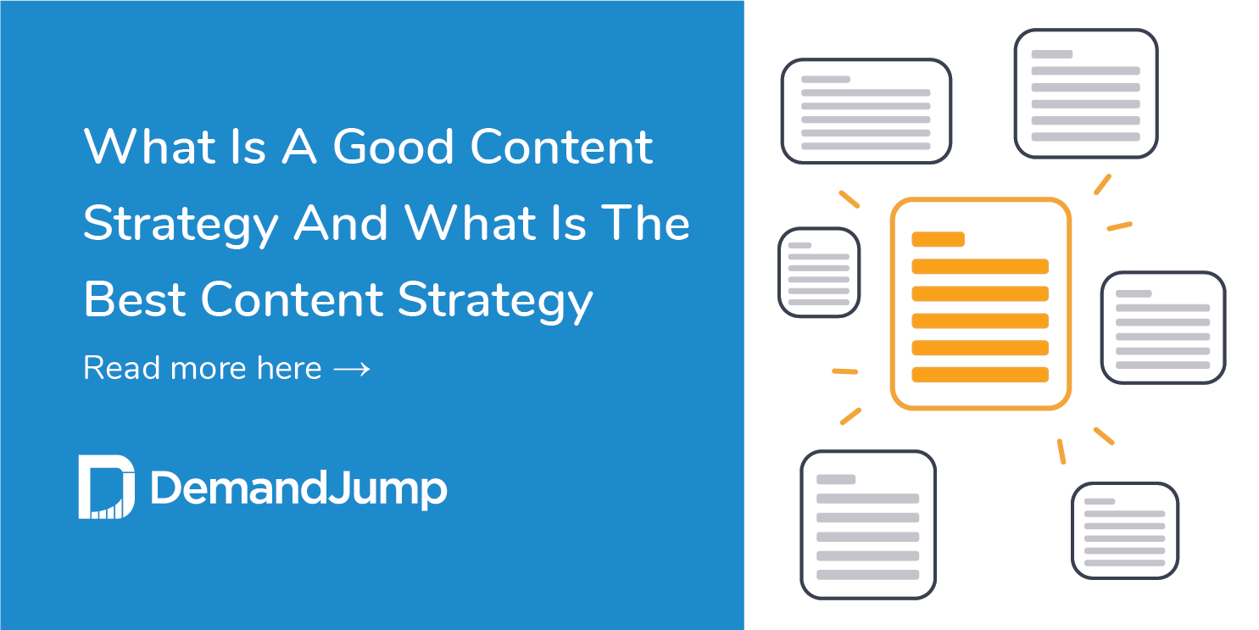What Is A Good Content Strategy And What Is The Best Content Strategy?
December 10, 2020 •DJ Team

Content marketing strategy today has no paint-by-the-number formula to reach your targeted audience. Each business has a unique story to tell—a distinctive personality that is valuable. Your business in particular contains inherent nuances in its model that, if projected correctly, can be especially attractive and impactful with new audiences.
But we all know not every business connects with their audience successfully through their content marketing strategy, and many well-intended content plans are left dead in the water after costly investment.
Or the well-intended content plan failed to garner half as much success as what was promised. You didn’t see the traffic you thought you would. The analytics revealed a distinct gap between your strategic goals and how viewers responded to your content. Here lies the difference between a good content strategy and the best content strategy: true audience engagement with your brand.
Take a listen to DemandJump's "Page One Or Bust" podcast for more information on why having a high-quality content strategy is so important. Check out a clip below:
What should a content strategy include?
A good content strategy knows to cover all its bases: develop lots of content based on defined strategic goals (website views, downloads, SEO, sales conversions) utilizing multiple platforms that reach audiences at every possible point of contact. Social media, video, blog campaigns, podcasts, web content—meet audiences at their chosen market of curiosity and offer engaging content.
That’s a good content strategy, sure. It works for a lot of businesses with fair-to-middling success and achieves about as much traction with viewers as the effort content creators put behind it.
The best content strategy is more tactical and people-savvy. It shares similar goals and utilizes many of the same platforms a good strategy does, but the directive is not to garner views or boost traffic—it’s to create an authentic experience with followers, viewers, and customers that leads to long-term, recurring interactions.
Pro tips:
- Limit or eliminate direct reference to your business or brand. Every plug is an opportunity for your audience to bail out. Instead, focus on the quality of content. What is your audience getting from this?
- Don’t fear directing your audience towards other content. All are guilty of going down rabbit holes with multiple tabs open on our browser, articles half-read, links to follow-up with. But audiences are remarkable at remembering pieces of content that led to more information, more engagement—and we value those sources. And every step your audience takes to engage further is a step closer they get to a sale.
- Content effectiveness can be measured through data analytics. The best content marketing strategy uses that data to inform future content to know what resonates best across various platforms.

What are strategic goal examples?
A good content strategy will pin-up general, all-purpose strategic goals like balloons on a wall and will use their content as the darts, hoping to see some results. With enough of those goals, you’re sure to hit something—but that doesn’t win the best prize.
Instead, determine what exactly you’re trying to achieve; be as specific as possible with what you want to happen.
Define audience engagement. We all want to engage our audiences, but this is a vague, immeasurable statement. Put actionable goals behind the word “engagement” to build the best content marketing strategy.
- Does your content ask audiences to share contact information?
- If customer satisfaction is a goal, do you have tools to measure this?
- Is there a niche audience you’re targeting?
- What percent of viewers do you expect to follow hyperlinks or backlinks?
- What purpose should your CTA (call-to-action) serve?
Set a definitive, traceable expectation for customer conversion, whether that be ECOMM to sales, or converting a potential customer to a paying customer. Track customer conversion rates as you onboard more content and measure content analytics against your expectations.
Identify realistic SEO potential. The best content strategies know where the business stands and knows how to set practical SEO goals. Your strategy is going to involve a fairly large team, and you need to share what’s possible and what is too idealistic—doing so informs how specific pieces of content will connect with your audience.

What makes a good content strategist?
Through comparison we’ve seen that the best content market strategies are goal-oriented, intentional, and measurable. And an effective content strategist gauges how well a content strategy connects with an audience through these three descriptors. This is a task that can’t be micromanaged; it involves too much content, too much data. Instead, your content strategist should be the gatekeeper to ensure the message remains intact.
So how do you manage the volumes of content and data?
A strong team collaborating in a close setting can help, but look to the tools available to manage what all goes into a content marketing strategy. DemandJump automates your content strategy and keyword research, cutting the time it takes to create content by over 50%. Try it free for yourself.
Featured Articles
Categories
- Attribution Tracking (13)
- Channel Optimization (11)
- Consumer Insights (68)
- Content Marketing (251)
- Data Science (8)
- Digital Marketing (6)
- Digital Transformation (26)
- Enterprise (10)
- Lead Generation (14)
- Market Intelligence (8)
- Marketing Analytics (39)
- Marketing Attribution (57)
- Marketing Management (153)
- Marketing Operations (86)
- Organic Search (222)
- Paid Search (52)
- Pillar-Based Marketing (63)
- Programmatic Advertising (9)
- SaaS Content (14)
- SaaS Marketing (29)
- Search Marketing (111)
- SEO Keyword Research (28)
- SEO Pillar (18)
- SEO Strategy (46)
- SMB (5)
- Website Content (12)

